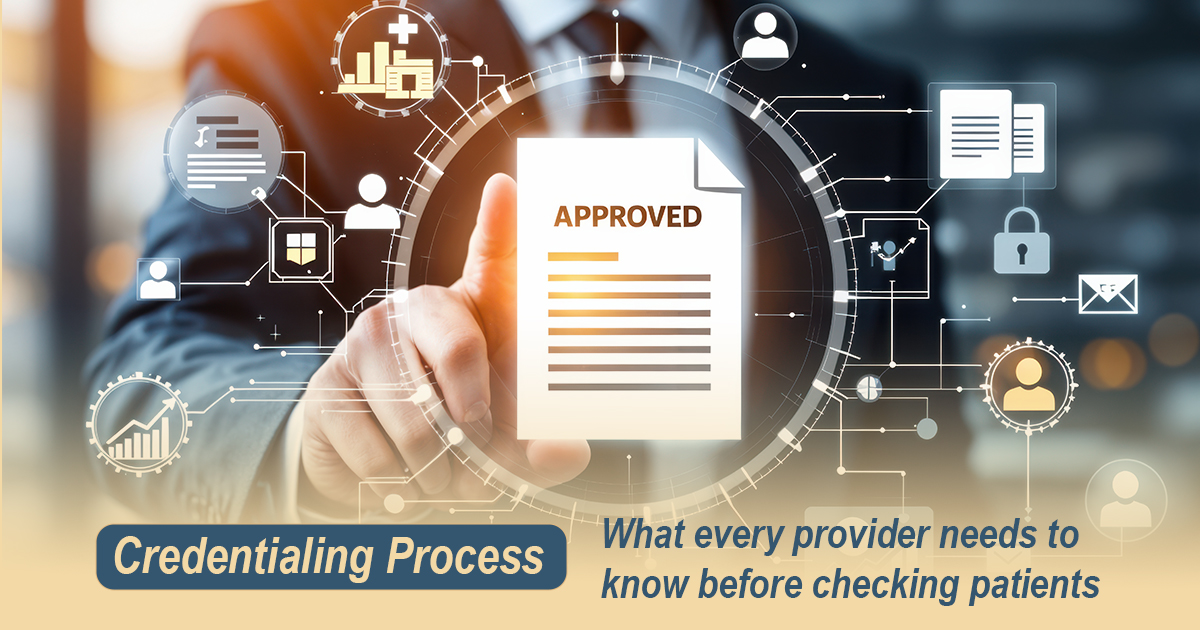Being a Healthcare provider, if you are entering the U.S. healthcare market without proper credentialing services, it’s like opening a clinic with the locked doors. Because of changing regulations, and increase timelines of process, providers must approach credentialing and enrollment as a first step. For healthcare providers, credentialing is a front-line task to determine how quickly you get paid.
If you are starting a solo practice, joining a group, or moving to another state, providers credentialing must be completed. In this blog, we will cover everything healthcare providers need to know before serving patients.
Credentialing and its importance
Credentialing is the verification of a healthcare provider’s qualifications, background, licenses, and training. Insurance companies, hospitals, and healthcare networks use this process to check that whether a provider meets the standards required to deliver services under their programs or not.
Once verified, then there is need of enrollment, provider need to add officially in payer’s network and authorized to submit claims for reimbursement. These two phases, credentialing and enrollment are required before a provider can legally bill for services.
In 2025, the importance of these steps has grown due to:
- Compliance requirements
- Scams and fraud detection technologies
- Audits and databases
For providers, delays or errors in this process mean delays in income, appointment cancellations, and a negative impact on patient care delivery.
Credentialing Timeline:
The average credentialing time has increased due to a backlog of applications and verification protocols. Here’s what a provider should expect:
| Step | Estimated Time |
| Information gathering | 1 week |
| Application submission | 2-3 days |
| Payer review and verification | 30–90 days |
| Enrollment confirmation | 2–3 days |
| Payer | Max. Processing Time |
| Medicare | 30 days |
| Medicaid | 60 days |
| Commercial Plans | 30-90 days |
Note: Processing timelines varies depends on the state, payer, and provider’s specialty. Medicare and Medicaid may also take additional time.
What You Need Before Seeing Patients
1. Personal and Professional Documents
Ensure the following are updated and available:
- Current state license(s)
- DEA registration
- Board certifications
- Educational credentials
- Work history with dates
- Malpractice insurance with claims history
2. CAQH Profile
Most payers rely on the Council for Affordable Quality Healthcare (CAQH) for provider data. Keep this profile updated at all times and include accurate supporting documents.
3. Payer Application Submission
Each payer has specific credentialing forms. Verify all details in:
- NPI (National Provider Identifier)
- Tax ID and W-9 form
- Practice address and contact information
Why Credentialing Errors Are Costly
Many providers underestimate how damaging credentialing delays can be. Here’s how it can affect your operations:
- Revenue Interruption: You cannot submit claims to insurance companies until enrollment is confirmed. Starting without approval means rejected or denied claims.
- Limited patient access: If you are not appearing in payer directories, patient feel harder to find and schedule with you.
- Contract Breaches: Your contract considered delayed if you join group with incomplete credentialing.
Common Challenges you can face in credentialing
- Incomplete Applications
Incomplete or missing documents can put your file on hold for weeks. Cross verifies all details before submitting the documents. - State Rules
Every state follows its own rules and requirements, process will be expedited if you take care of local guidelines. - Changing in location of Practice
Any change in employment, business structure, or practice address must be updated across all payers and systems, or claims will be denied. - Credentialing Expiry
Most payers require re-credentialing every 2–3 years. Mark your calendar and stay proactive to prevent network removal.
Credentialing process in 2025 is unique:
AI Verification
Correct documentation is necessary, because of advances technology, the insurers can easily detect the errors or mismatch, which can slow down the process.
Real-Time Payer Directory Updates
Providers are now required to maintain real-time accuracy in payer directories. Inaccurate or outdated information can result in fines or removal from directories.
Telehealth and Multistate Licensing
With telehealth growth, providers are obtaining licenses in multiple states. Each state requires separate credentialing, increasing the administrative load.
How to Stay Ahead: Provider Action Plan
Being a healthcare provider if you are planning to start or change a practice, below is the checklist:
Start Early
Begin the credentialing process at least 90–120 days before you intend to start seeing patients.
Centralize Documentation
Keep all professional documents at one place. Properly Scan certificates, licenses, IDs, and reference letters for your ease.
Track Each Application
Use a spreadsheet or credentialing portal to track the status of applications for each payer.
Communicate with Payers
Follow up is very important, make sure to do it in every 2 weeks.
Notify Changes Immediately
Update all credentialing applications and directories with any changes in your name, address, affiliations, or status.
Role of Credentialing Services Providers – One O’Seven RCM
One O’Seven RCM handles the process for you. The services typically include:
- Gathering required documents
- Preparing and submitting applications
- Monitoring status across payers
- Managing CAQH and re-credentialing updates
- Handling payer communications
Let’s Partner with One O’Seven RCM to get peace of mind that no step is missed, timelines are monitored, and securing faster approvals. This prevents lost revenue, protects your reputation, and allows you to focus on patient care.
Conclusion
Credentialing in 2025 is no longer just a paperwork, it’s a critical gateway to delivering care and securing income. If Credentialing and Enrollment process get delayed, there will be a consequence on revenue performance.
For healthcare providers in the United States, preparing for providers credentialing with the same precision as a clinical procedure can be difficult and challenging.
Contact Us, we support healthcare professionals across specialties by managing the entire credentialing journey. From initial setup to ongoing payer relationships, we help providers stay active, visible, and fully enrolled before they ever step into the exam room.

